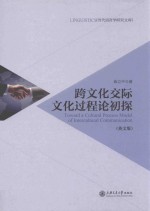

跨文化交际文化过程论初探 英文版PDF电子书下载
- 电子书积分:10 积分如何计算积分?
- 作 者:翁立平著
- 出 版 社:上海:上海交通大学出版社
- 出版年份:2015
- ISBN:9787313138873
- 页数:206 页
Chapter 1 Introduction 1
1.1 Statement of the problem and significance of the present research 1
1.2 Research objectives and central theme 4
1.3 Research questions and hypotheses 5
1.4 Research methodology applied 7
1.5 Structure of the book 7
Chapter 2 Diverse Views of Culture in Intercultural Communication(IC)Studies 9
2.1 Conceptualizing culture 9
2.1.1 Catcgorization of definitions of culture 9
2.1.2 Structural-functional view of culture 10
2.1.3 Process view of culture 13
2.1.4 Critical view of culture 15
2.1.5 Postmodern view of culture 16
2.2 Philosophical foundations of diverse views of culture in IC 17
2.2.1 Two primary dimensions 17
2.2.2 Three paradigms 18
2.2.3 Paradigm wars or paradigm integration? 20
2.3 Chapter summary 22
Chapter 3 The Fixed-Traits View of Culture:A Critical Analysis 24
3.1 Nature of the fixed-traits view of culture 24
3.1.1 What is culture? 24
3.1.2 How do cultures vary? 26
3.2 Representations of the fixed-traits view in contemporary IC scholarship 28
3.2.1 “Culture”in key IC publications in the US 28
3.2.2 “Culture”in selected Chinese IC publications 30
3.2.3 A“culture paradox”in contemporary research 32
3.2.4 Cultural dimensions and syndromes as“sophisticated stereotypes” 34
3.3 Contributions of the fixed-traits view 35
3.4 Limitations of the fixed-traits view 37
3.4.1 Conceptual challenges 38
3.4.2 Empirical challenges 42
3.5 Chapter summary 47
Chapter 4 Improvements of the Fixed-Traits View across Related Disciplines 48
4.1 Multiple-level cultural analysis 48
4.1.1 Individual level analysis of culture in cross-cultural psychology 48
4.1.2 Individual level analysis of culture in IC studies 49
4.1.3 Kulich's cultural analytical matrix 50
4.1.4 Summary 52
4.2 Emic approaches to culture 52
4.2.1 Etic and emic approaches perceived as complementary 53
4.2.2 Etic and emic approaches perceived as incompatible 57
4.3 Chapter summary 61
Chapter 5 The Dynamic Process View of Culture:A Review 64
5.1 Defining culture 64
5.1.1 Culture as a loose network of shared knowledge 65
5.1.2 Uneven distribution of cultural knowledge 66
5.1.3 Human agency in culture and psychology 68
5.2 Forms of cultural knowledge 70
5.2.1 Declarative knowledge 70
5.2.2 Procedural knowledge 71
5.3 Location of cultural knowledge 72
5.4 Application of cultural knowledge 74
5.4.1 Availability of cultural knowledge 75
5.4.2 Chronic accessibility of cultural knowledge 76
5.4.3 Temporary accessibility of cultural knowledge 76
5.4.4 Applicability of cultural knowledge 78
5.4.5 Moderating factors in cultural knowledge activation 78
5.5 Chapter summary 81
Chapter 6 Culture as Dynamic Processes in IC 82
6.1“Normalizing”culture 82
6.1.1 Culture as the whole story 82
6.1.2 Culture as part of the story 85
6.2 Understanding IC:A dynamic process view of culture 87
6.2.1 A cursory review of some key IC models 87
6.2.2 Underemphasized intergroup dimensions of IC 89
6.2.3 Proposing a cultural process model of IC 92
6.3 Chapter summary 99
Chapter 7 Initial Tests of the Cultural Process Model of IC(1):Study Ⅰ 101
7.1 Culture priming 101
7.2 Research background 102
7.3 Significance of Study Ⅰ 103
7.4 Tentative research hypothesis 104
7.5 Pilot study and modified hypothesis 106
7.6 Method 107
7.6.1 Subjects 107
7.6.2 Culture and neutral primes and the social attribution task 107
7.6.3 Procedures 110
7.6.4 Data analysis 111
7.7 Results 111
7.8 Discussion 115
7.9 Chapter summary 119
Chapter 8 Initial Tests of the cultural Process Model of IC(2):Studies Ⅱ and Ⅲ 120
8.1 Study Ⅱ 120
8.1.1 The proverb sampling method 120
8.1.2 The IC dimension of the experiment 122
8.1.3 Research hypotheses 123
8.1.4 Method 124
8.1.5 Data analysis and results 125
8.1.6 Discussion 135
8.2 Study Ⅲ 138
8.2.1 What is“over-tuning effect?” 139
8.2.2 The case 140
8.2.3 Case analysis 144
8.3 Chapter summary 151
Chapter 9 General Discussions and Conclusion 152
9.1 Summary of the research 152
9.2 Theoretical and practical implications of the present research 155
9.2.1 Theoretical implications 157
9.2.2 Practical implications 162
9.3 Limitations of the present research 164
9.4 Directions for future research 167
Appendixes 170
References 185
- 《东北民歌文化研究及艺术探析》(中国)杨清波 2019
- 《大学英语教学的跨文化交际视角研究与创新发展》许丽云,刘枫,尚利明著 2020
- 《北方曲艺音乐初探 下》萧作如著 2020
- 《卓有成效的管理者 中英文双语版》(美)彼得·德鲁克许是祥译;那国毅审校 2019
- 《北方曲艺音乐初探 上》萧作如著 2020
- 《跨文化交际背景下的中西文化比较研究》任永进,贺志涛著 2019
- 《生态文化建设的社会机制研究》阮晓莺著 2019
- 《党内政治文化建设指南》苏玉主编 2017
- 《白纻舞及其歌辞的文化解读》王俊,曹化根著 2019
- 《社会文化系统中的翻译》姜秋霞,杨正军 2019
- 《单逨传奇》刘高奇,单百平著 2019
- 《简明大学物理实验教程》黄立平主编 2019
- 《云南少数民族传统舞蹈》葛树蓉,吴世平著 2018
- 《当代文化视域下的中国钢琴教育研究与实践》孙淑平著 2019
- 《峨眉丛谈》魏福平著 1986
- 《西方国家的新贸易保护主义与中国的应对措施研究》李雪平著 2019
- 《成长的声音》邬易平著 2019
- 《秘书实用英语》刘敏主编;崔立平,王晓宇副主编 2011
- 《健康由自己把握》赵国平著 2018
- 《中国抗日战争史 第8卷 战后处置与战争遗留问题》步平著;步平,王建朗主编 2019
